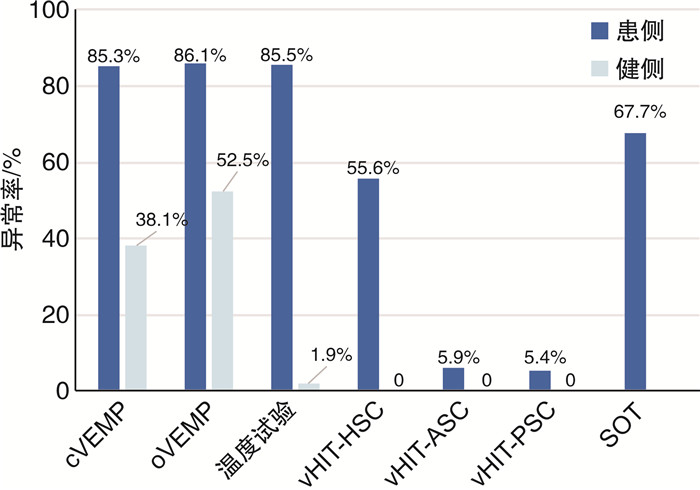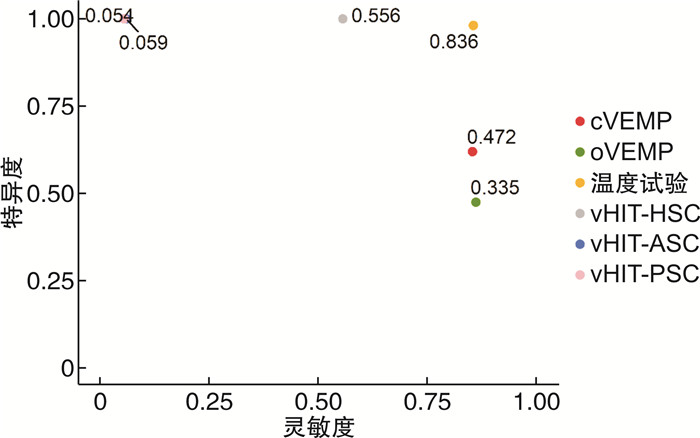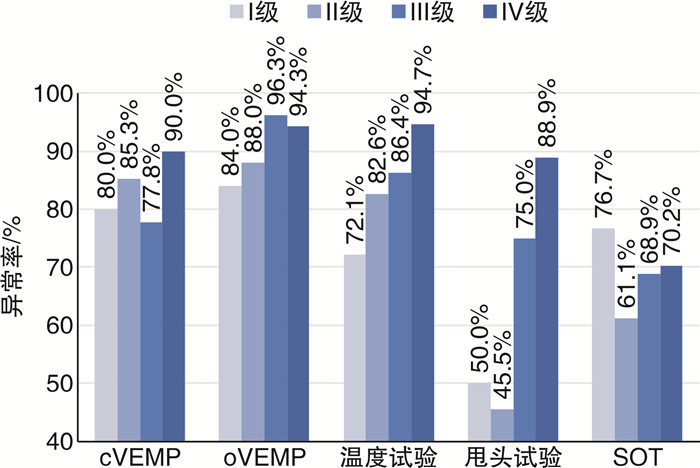-
摘要: 目的 通过对听神经瘤患者前庭功能进行多方面评估,探究不同前庭检测技术在前庭功能障碍诊断、代偿建立及肿瘤起源分析中的价值,为听神经瘤患者的前庭功能预后评价及康复策略提供借鉴。方法 回顾性分析2013年3月—2020年3月复旦大学附属眼耳鼻喉科医院耳鼻喉科收治的335例听神经瘤患者的多种术前前庭功能检查结果,包括温度试验、颈性前庭诱发肌源性电位(cVEMP)、眼性前庭诱发肌源性电位(oVEMP)、视频头脉冲试验(vHIT)及感觉统合试验(SOT),研究其在听神经瘤侧别判断中的灵敏度、特异度和约登指数等,分析各项检查的内部相关性,以及在肿瘤起源判断中的价值,并根据SOT结果对患者前庭代偿情况进行总结。结果 入组患者中温度试验、cVEMP、oVEMP、vHIT、SOT检查异常率依次为85.3%、86.1%、85.5%、55.6%和67.7%,其中温度试验表现出相对最优的灵敏度(0.855)、特异度(0.981)和约登指数(0.836)。相关性分析结果提示随听神经瘤Koos分级增加,温度试验、vHIT和oVEMP检查异常率也在增加(Cochran-Armitage趋势检验,P< 0.05)。各项前庭功能检查异常与对应肿瘤来源神经之间未见显著相关性(P>0.05)。结论 多数听神经瘤患者术前存在前庭相关平衡障碍。超过50%的患者存在两项及以上前庭功能检查异常,提示前庭功能损伤范围较广。Koos分级越高,患者术前温度试验、vHIT和oVEMP检查异常率也更高。在判断患侧前庭功能异常方面,温度试验相对于cVEMP、oVEMP和vHIT检查显示出更佳的灵敏度与特异度。Abstract: Objective This study was conducted to evaluate the applications of vestibular function tests in diagnosis, identifying tumor origins and prognosis of vestibular rehabilitation of patients with acoustic neuroma.Methods This research is a single-center cross-sectional clinical study, which retrospectively analyzed the data of 335 patients with acoustic neuroma from March 2013 to March 2020 in the Eye and ENT Hospital of Fudan University. The study included caloric test, cervical and ocular vestibular evoked myogenic potentials(cVEMP, oVEMP), video head impulse test(vHIT) and sensory organization test(SOT). Firstly, the sensitivity, specificity, and Yoden index of each test were calculated. Secondly, the internal relevance of these tests was studied for application in judging the origins of the tumor.Results The abnormal rates of caloric test, cVEMP, oVEMP, vHIT and SOT was 85.3%, 86.1%, 85.5%, 55.6% and 67.7% in these participants. Among all the vestibular function tests included, the caloric test showed the best sensitivity(0.855), specificity(0.981), and Yoden index(0.836). The study found that the higher the Koos grades, the higher the abnormal rates of the caloric test, vHIT, and oVEMP(Cochran-Armitage test,P< 0.05). There was no significant relationship between the combination of abnormal vestibular function tests and tumor origin nerves(P>0.05).Conclusion Majorlty of the participants in this study with acoustic neuroma showed abnormal results in SOT related to poor balance control. More than half of the patients had at least two abnormal result of the battery of vestibular function tests, among which the caloric test was proved to have better sensitivity and specificity. The higher the Koos grades of the tumor, the higher the abnormal rates of the caloric test, vHIT, and oVEMP.
-
Key words:
- acoustic neuroma /
- vestibular function test /
- temperature test
-

-
表 1 VEMP和温度试验定位前庭神经损伤的准确度
项目 结果 前庭上神经 前庭下神经 准确度/% P值 cVEMP 异常 19 20 47.1 >0.05 正常 4 8 oVEMP 异常 19 23 47.6 >0.05 异常 4 5 温度试验 异常 20 31 41.5 >0.05 异常 7 7 -
[1] Koo M, Lai JT, Yang EY, et al. Incidence of Vestibular Schwannoma in Taiwan from 2001 to 2012: A Population-Based National Health Insurance Study[J]. Ann Otol Rhinol Laryngol, 2018, 127(10): 694-697. doi: 10.1177/0003489418788385
[2] Huang X, Xu J, Xu M, et al. Clinical features of intracranial vestibular schwannomas[J]. Oncol Lett, 2013, 5(1): 57-62. doi: 10.3892/ol.2012.1011
[3] Humphriss RL, Baguley DM, Axon PR, et al. Preoperative audiovestibular handicap in patients with vestibular schwannoma[J]. Skull Base, 2006, 16(4): 193-199. doi: 10.1055/s-2006-950388
[4] Hunter JB, Francis DO, O'connell BP, et al. Single Institutional Experience With Observing 564 Vestibular Schwannomas: Factors Associated With Tumor Growth[J]. Otol Neurotol, 2016, 37(10): 1630-1636. doi: 10.1097/MAO.0000000000001219
[5] Lees KA, Tombers NM, Link MJ, et al. Natural History of Sporadic Vestibular Schwannoma: A Volumetric Study of Tumor Growth[J]. Otolaryngol Head Neck Surg, 2018, 159(3): 535-542. doi: 10.1177/0194599818770413
[6] Nilsen KS, Lund-Johansen M, Nordahl S HG, et al. Long-term Effects of Conservative Management of Vestibular Schwannoma on Dizziness, Balance, and Caloric Function[J]. Otolaryngol Head Neck Surg, 2019, 161(5): 846-851. doi: 10.1177/0194599819860831
[7] Myrseth E MP, Wentzel-larsen T, GOPLEN F, et al. Untreated vestibular schwannomas: vertigo is a powerful predictor for health-related quality of life. [J]. Neurosurgery, 2006, 59: 67-76.
[8] Carlson ML, Tveiten OV, Driscoll CL, et al. Long-term quality of life in patients with vestibular schwannoma: an international multicenter cross-sectional study comparing microsurgery, stereotactic radiosurgery, observation, and nontumor controls[J]. J Neurosurg, 2015, 122(4): 833-842. doi: 10.3171/2014.11.JNS14594
[9] Chiarovano E, Darlington C, Vidal PP, et al. The role of cervical and ocular vestibular evoked myogenic potentials in the assessment of patients with vestibular schwannomas[J]. PLoS One, 2014, 9(8): e105026. doi: 10.1371/journal.pone.0105026
[10] Teggi R, Franzin A, Spatola G, et al. Vestibular assessment in patients with vestibular schwannomas: what really matters?[J]. Acta Otorhinolaryngol Ital, 2014, 34(2): 123-128.
[11] Zhou Y, Zhao W, Tian L, et al. The prediction of the tumor size of a vestibular schwannoma by clinical performance and vestibular function tests[J]. J Neurooncol, 2018, 140(3): 679-686. doi: 10.1007/s11060-018-2998-y
[12] Huang CH, Wang SJ, Young YH. Correlation between caloric and ocular vestibular evoked myogenic potential test results[J]. Acta Otolaryngol, 2012, 132(2): 160-166. doi: 10.3109/00016489.2011.624120
[13] Borgmann H, Lenarz T, Lenarz M. Preoperative prediction of vestibular schwannoma's nerve of origin with posturography and electronystagmography[J]. Acta Otolaryngol, 2011, 131(5): 498-503. doi: 10.3109/00016489.2010.536991
[14] West N, Sass H, Klokker M, et al. Video Head Impulse Test Results in Patients With a Vestibular Schwannoma-Sensitivity and Correlation With Other Vestibular System Function Tests, Hearing Acuity, and Tumor Size[J]. Otol Neurotol, 2020, 41(5): e623-e629. doi: 10.1097/MAO.0000000000002600
[15] Stangerup SE, Tos M, Thomsen J, et al. True incidence of vestibular schwannoma?[J]. Neurosurgery, 2010, 67(5): 1335-1340. doi: 10.1227/NEU.0b013e3181f22660
[16] 吴皓, 张治华. 听神经瘤诊断和治疗建议[J]. 中华耳鼻咽喉头颈外科杂志, 2014, 49(3): 181-185. doi: 10.3760/cma.j.issn.1673-0860.2014.03.002
[17] Rahne T, Plossl S, Plontke SK, et al. Preoperative determination of nerve of origin in patients with vestibular schwannoma[J]. HNO, 2018, 66(Suppl 1): 16-21.
[18] He YB, Yu CJ, Ji HM, et al. Significance of Vestibular Testing on Distinguishing the Nerve of Origin for Vestibular Schwannoma and Predicting the Preservation of Hearing[J]. Chin Med J(Engl), 2016, 129(7): 799-803.
[19] Hruba S, Chovanec M, Cada Z, et al. The evaluation of vestibular compensation by vestibular rehabilitation and prehabilitation in short-term postsurgical period in patients following surgical treatment of vestibular schwannoma[J]. Eur Arch Otorhinolaryngol, 2019, 276(10): 2681-2689. doi: 10.1007/s00405-019-05503-8
[20] 韩朝, 田亮, 王璟, 等. 颈性前庭诱发肌源性电位正常值及影响因素的探讨[J]. 中国眼耳鼻喉科杂志, 2015, 15(2): 101-104. https://www.cnki.com.cn/Article/CJFDTOTAL-YRBH201502008.htm
[21] Erickson NJ, Schmalz P GR, Agee BS, et al. Koos Classification of Vestibular Schwannomas: A Reliability Study[J]. Neurosurgery, 2019, 85(3): 409-414. doi: 10.1093/neuros/nyy409
[22] Blodow A, Heinze M, Bloching MB, et al. Caloric stimulation and video-head impulse testing in Meniere's disease and vestibular migraine[J]. Acta Otolaryngol, 2014, 134(12): 1239-1244. doi: 10.3109/00016489.2014.939300
[23] Sichnarek J, Mrazkova E, Zathurecky E, et al. Comparing results from vestibular caloric stimulation and vHIT from a specialised outpatient clinic[J]. Int Tinnitus J, 2019, 23(1): 1-5.
[24] Tranter-entwistle I, Dawes P, Darlington CL, et al. Video head impulse in comparison to caloric testing in unilateral vestibular schwannoma[J]. Acta Otolaryngol, 2016, 136(11): 1110-1114. doi: 10.1080/00016489.2016.1185540
[25] Fetter M. Acute unilateral loss of vestibular function[J]. Handb Clin Neurol, 2016, 137: 219-229.
[26] Ribeyre L, Frere J, Gauchard G, et al. Preoperative balance control compensation in patients with a vestibular schwannoma: does tumor size matter?[J]. Clin Neurophysiol, 2015, 126(4): 787-793. doi: 10.1016/j.clinph.2014.07.022
[27] West N, Moller MN, Hansen S, et al. Audiovestibular Loss of Function Correlates in Vestibular Schwannomas[J]. J Int Adv Otol, 2018, 14(2): 161-165. doi: 10.5152/iao.2018.5500
-

| 引用本文: | 郝维明, 黄若男, 赵卫东, 等. 听神经瘤患者前庭功能评估及临床价值[J]. 临床耳鼻咽喉头颈外科杂志, 2022, 36(12): 910-915. doi: 10.13201/j.issn.2096-7993.2022.12.004 |
| Citation: | HAO Weiming, HUANG Ruonan, ZHAO Weidong, et al. Evaluation and clinical practice of vestibular function tests in acoustic neuroma[J]. J Clin Otorhinolaryngol Head Neck Surg, 2022, 36(12): 910-915. doi: 10.13201/j.issn.2096-7993.2022.12.004 |
- Figure 1.
- Figure 2.
- Figure 3.




 下载:
下载:

